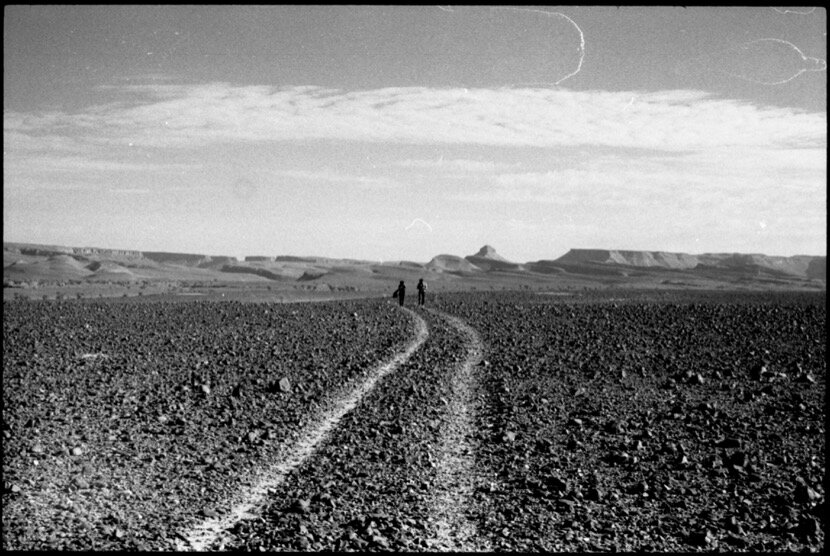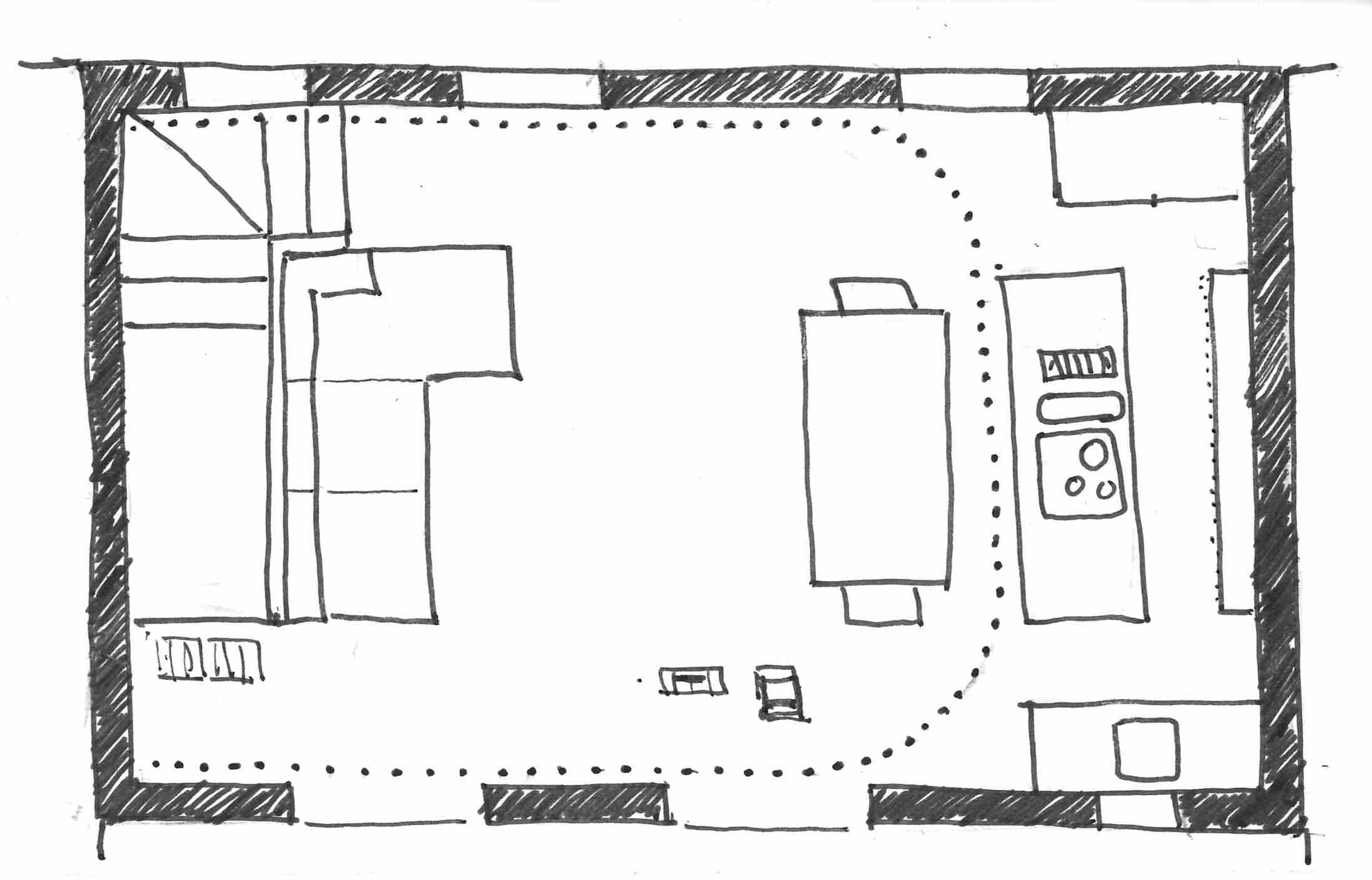dimensions of perceptions
When I decided to do some researches on people living out of the oases, I didn’t expect there were so many issues to study; among many others there was one that still keeps me thinking about, especially nowadays.
Walking in wide open spaces allows you to approach this topic in a different way considering dimensions not as physical features but as combinations of variable attributes, in space and time, but also and maybe more important, in spaces and times created by your imagination. This departing point, where I arrived after several years thinking and experiencing these variations, led me to dissociate perceptions from dimensions; you cannot trust in your own senses when you are in the desert (especially in your sight), it’s the knowledge of the territory you are walking through on which you must base your decisions, not in your sensorial perceptions.
I do not want to theorise about the concept of dimension and perception, I would just want to share some situations I have experienced that could be useful, even in other regions.
dimensions of a desert
01
The first time I had a thought on this matter it was related to landscapes. The fact that they could change so quickly, shows contradictory feelings on speed relativity. I used to drive all over the south of Morocco and I always had the sensation that the desert only had a few kind of landscapes with sand, oases and stones. So, my mind was upset during the caravans (Project Qafila) when we crossed (by foot) 5 different landscapes in just one day, having the same sensation when travelling in a high speed train between Malaga and Madrid, but instead of going at 300 km/h, we were walking at 5 km/h. Even more important, I had the sensation of been travelling from one planet to another, as if I were a character of Interstellar (film by Christopher Nolan from 2014), seeking for a planet where to live. Planets made of green gravel, sand with white pebbles, white river pebbles, brown boulders, black boulders... (How important is geology to understand a territory!).
It is a paradoxical situation, but to travel between planets (at a theoretical light speed), you have to slow down (in every sense) and you have to walk in order to touch and feel the ground.
walking in the desert is an interstellar journey
02
The last day of Qafila Oula, we had to cross an old caravan passage between two palm groves in Zagora, Ktaoua and M’hamid (Foum Lahsen); I knew the mountains we had on our left were the border with Algeria and also that there were no oases, at least until the Adrar in Mauritania (1 000 km far from there). I remember having a feeling of vertigo as if behind the mountains there were a giant cliff with a powerful magnetic attraction that could catch you and make you fall down. It did not matter if I knew that cliff was an illusion and that the territory was completely horizontal, in my mind, it was vertical and deep, very deep...
Now that I have been on the other side of that folded and unknown territory, in the Mauritanian region of the Adrar, my perception (even without really crossing it from M’hamid) has changed radically, I have already no vertigo because I know I will be able to walk through both territories no matter if the ground is horizontal or vertical once understood they were in different but complementary dimensions.
your mind can fold landscapes
03
I also learned that a landscape can harbour another one and that you cannot see it till you are in it (the transition could be sudden and unexpected). Now, every time I visit southern regions I take a look from my car, knowing that while my eyes see one space, my mind reminds me that there are more spaces insides, hidden, and if I want to discover them, I have to stop, to walk and to get lost.
spaces within spaces
Along the (nomad) routes, I have seen how geography shaped the territory we were passing through; mountains, valleys, palm groves, rivers and streams beds, dunes, plains... all these elements can generate specific dimensions where sometimes you feel yourself abandoned in the middle of nowhere, and therefore exposed to dangers, others confined in small areas but protected. In both situations, we were able to establish intimate places to settle down and rest, but we were also able to create mobile spaces while walking with the nomads, it was like moving inside an artificial bubble but created naturally and spontaneously. Since then, I have observed that we have always created intimate and protective spaces around us, that could adapt themselves to each situation and that they were moulded by trust and complicity between travellers; although sometimes they were physical spaces delimited by the dunes, by the shadows of a tree, by our luggage or just by a carpet, becoming architectural habitats without architecture, but it could be also possible to combine real boundaries with illusory ones and in those cases dimensions became more complex and interesting.
overlapped dimensions
04
Mistrust of my senses was confirmed when we were crossing the Lake Iriki, near Erg Chegaga (Qafila Thania), a 20 km wide terrain with no trees, no plants, no dunes, no stones... Before starting the journey, one of the guides, Said, told us we could start walking towards a small mountain (Madouar Sghir) and we could wait them there, under the first trees because there was no possibility of getting lost. I walked with M’barek and at the beginning we asked ourselves how long would it take us to arrive there, I said it depended on how big the trees we could barely see in the background were, if they were big we were far away, but if they were small ones, we could arrive faster. The problem arised one hour later because the trees were becoming smaller. It had no sense for me, but at that precisely moment, M’barek was sharing with me the same thought, for him the trees were also decreasing in height. We could not understand what was going on but something was wrong with our perceptions.
There was also an issue with the dunes; they appeared and disappeared in front of us. The first thought was the metaphor of dunes as sea waves but, could they really move as water does? It had no explanation but it was happening, M’barek and I could see some dunes waiting before arriving to the “decreasing” trees, although they were no longer there later. Trying to find a justification, we thought we were sick, because of the heat or because the lack of hydration. Finally, we realised dunes disappeared when the sun was hidden by the clouds, it is to say, shadows showed us that the terrain was not flat, it had volumes that corresponded with the small dunes.
the desert is a battlefield between illusion and reason
05
One day (Qafila Thalitha) we arrived to a small village (Oum Al Alek near Akka) to buy some fresh food, it was just before the sunset and the sky was covered by mist. When we were leaving, walking the main street, the scene was quite disturbing, with the façades of de building illuminated with a dim light and a black darkness waiting for us at the end of village. None of us knew that territory and we did not know what was expecting us there. Instead of having fear, I was exultant for choosing the desert over the “civilisation”, darkness over light, in a new experience where we were moving without visual references. Until that moment, I had always walked by night under the moonlight, the starlight or I had settled down the camp before the nightfall, but I had never searched for a place to sleep in the middle of the (black) night, seeing absolutely nothing.
In our imaginary, darkness is related to evil and therefore physical darkness (not blindness) scares us, specially in the desert; however it has been a very powerful experience, maybe a way to better understand dimensions because your sight cannot betray you, it doesn’t matter if you can see one meter ahead you using a headlamp, you are navigating in a black space and there is no horizon, there are no references.
walking in the darkness is the closest sensation to levitation
06
The day before arriving in Tighmert (Qafila Thalitha) I had checked the milestones we were going to overcome, so we could have an idea of the time needed to arrive to the end of the caravan. We knew we were going to find the River Noun on our left and that we were going to follow it till a cultivated land that was supposed to be in the middle of the journey. Nevertheless, once near the river I saw on the background a big green space and I asked myself, is it the garden or already the oasis? It couldn’t be the oasis because we had been walking just for one hour and a half and in theory, it was going to take us three hours to complete the journey; however the image that arrived to my eyes was insisting that the oasis was closer than expected and they tried to convince me that the green area I had seen on the maps was just a farm land with some few trees and that we probably would have already passed it. Despite the visual evidence, my reasoning refused to accept this unusual and sudden variation of distances because there were 15 km from the camp to the oasis and we could not have done them in just half of the time, especially having headwind and rain, so it definitely couldn’t be the oasis.
It had to be the tiredness or my desire of finishing the caravan the reason my mind tried over and over again to convince me those trees were already the oasis of Tighmert. When we left the garden behind I realised my senses were completely wrong and the reasoning based on topographic data were right.
desire is a dangerous builder of illusions and dimensions
07
In some places, geography is so complex that without a GPS is very complicated to get positioned, even using accurate maps. When there are so many mountains, streams and micro valleys inside valleys it is very easy to get lost, like it happened to me for two days during Qafila Rabiaa (between Foum Lachar and River Lmahsar). Our guides knew the route but not so well to control distances and times to get from one point to another, so they could not explained exactly where we were. It was a strange sensation because I got use to this kind of situation when there were dunes or a flat terrain with no mountains around, but it never happened to me when being between mountains and valleys.
An excess of information can be confusing and blinding if you don't know how to recognise the key references, regardless of what your senses can suggest to you. There are other situations where apparently there are no references, there are always, but to find them you have first to decode the dimensions where you are navigating through.
navigating the desert requires constant codes decryptions
08
During the first days of Qafila Oula, we walked first between dunes, then straight because the terrain was completely flat and compact, with no path to follow. It was great to feel the same freedom you have when sailing. One day we were heading to an specific point that we could see from afar and we started to follow a narrow and winding path between pebbles but it started to take us away of the theoretical straight line and therefore, away from the quickest way to arrive to our destination. At that moment I told myself, why are you following that path if it makes you walk longer instead of taking advantage of the possibilities to walk wherever you want as you have being doing from the beginning?
In many aspects of our lives, we use to follow guidelines, some of them are a choice of us, others are imposed, but sometimes we get carried away, losing the ability to question ourselves if they are appropriate or not, fearing that if we get out of the path, we will be wrong or we will get lost.
The desert offers us different options when it comes to navigating in it but in most cases, it will be the elements that will decide our way, not us, and knowing that circumstances will change constantly and at any time, forcing us to change our paths and moving from one dimension to another permanently. To do this, you have to be trained and above all you have to know how to accept those changes.
some dimensions force us to question ourselves
09
In September 2013, I slept for the first time under the stars in a wide territory, completely flat and with nothing around me in 20 km. Lying on the ground and turning my head from east to west, I had an astonishing 180º view under the starry sky, even with the Milky Way. Nevertheless what really shocked me was the perception of being under the heavenly dome, a concept we all have already heard about but impossible to observe from the cities. These experiences are difficult to forget and since then, every time I come to the desert I try to sleep outside, under the stars, it has become a vital need and if I can do it with nomads even better, because it is the best way to understand their relation with the stars, and therefore with their universes.
After years walking, talking and learning from nomads my position from which I watch the stars has changed, I cannot understand or explain it but I feel I am not any longer a distant observer under a dome, I feel as if I were another element in a multidimensional space and that awareness lets me now move freely in my own world.
the desert is an unipersonal space launch device
10
I have tried to explain the complexity of dimensions in the desert, their variations, their scales and their limits according to my own experience. Perhaps the main feature that I would stand out among all them, would be the ability the desert has to change (us) our perceptions, allowing us to create new boundaries and therefore new real and imaginary spaces. Moreover, I have been thinking lately if this capacity remains when we are in cities and I think it does, except that those “urban dimensions” are defined by other references and codes, most of them artificial and unnecessary ones, hence the resulting dimensions are more distorted, affecting us, and those around us, in a direct and negative way.
In my personal case, there are periods of time in which I usually lock up in my apartment and in my office, finishing projects in order to be able to come back to the desert. In those moments I am aware I am between four walls, in a small city limited by two seas and a border, however, it doesn’t prevent me to also think that I live in a larger geographical zone, the Strait of Gibraltar, and thanks to my friends and my (educational, cultural, research...) activities, my area of movement is in fact now delimited by three “seas” (the Mediterranean, the Atlantic and the Sahara), therefore my limits are not anymore those of my city; besides, in the coming years I hope it will be the River Senegal my new limit, that is to say, my vital territory will be that of old nomads and caravans.
The desert has taught me to create my own dimensions; real or imaginary; variable and adaptable at all times and in all circumstances; dimensions that can be organised in constellations from elements sharing affinities. To get there, it is imperative, as in the desert, to learn to mistrust your senses (and thus to isolate yourself from interferences) and to choose your landmarks well in order to compose constellations where you can navigate in serenely.
the desert is a compilation of constellations
Ceuta, April 2020
texts and images Ⓒ Carlos Perez Marin
















































